Comparing Primary Health Care Strategies for CVD in Australia & India
VerifiedAdded on 2022/10/19
|11
|2934
|391
Report
AI Summary
This report provides a comparative analysis of primary health care strategies for addressing cardiovascular diseases (CVD) in Australia and India. It begins by defining primary health care and its guiding principles, then delves into the incidence of CVD in both countries, highlighting the alarming rise in India compared to Australia. The report explores the key strategy of consumer-concerned healthcare services, examining its implementation and impact in both nations. It then investigates the social determinants, environmental factors, and epidemiology of CVD, including socio-economic position, race, accessibility to healthcare, and environmental influences such as lifestyle choices and substance abuse. The report also discusses the role of nurses in managing and preventing CVD, emphasizing the importance of cultural competence, evidence-based guidelines, and holistic patient care. The conclusion emphasizes how nurses can decrease the effects of the disease by efficiently comprehending socio-economic determinants and improving healthcare services.
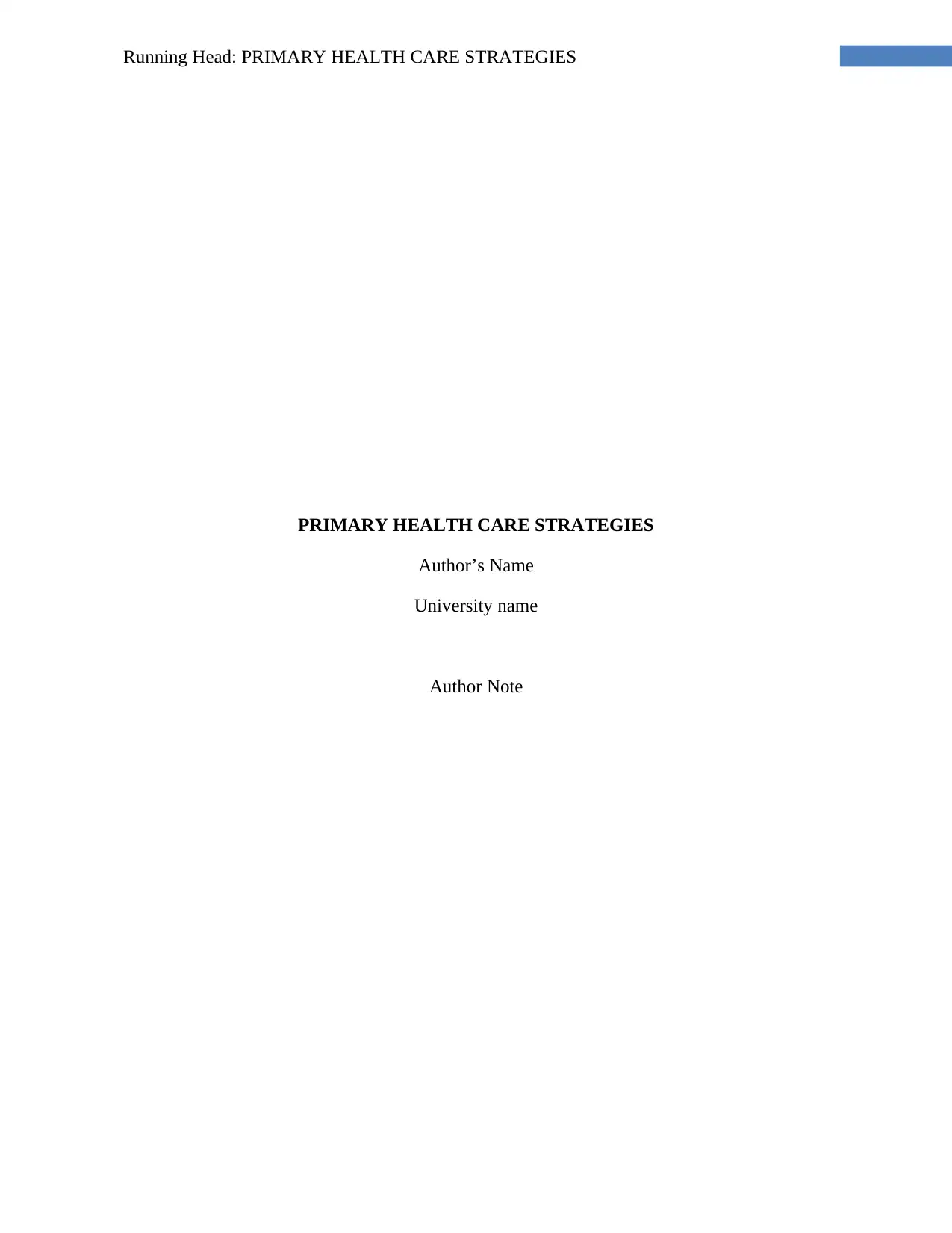
Running Head: PRIMARY HEALTH CARE STRATEGIES
PRIMARY HEALTH CARE STRATEGIES
Author’s Name
University name
Author Note
PRIMARY HEALTH CARE STRATEGIES
Author’s Name
University name
Author Note
Paraphrase This Document
Need a fresh take? Get an instant paraphrase of this document with our AI Paraphraser
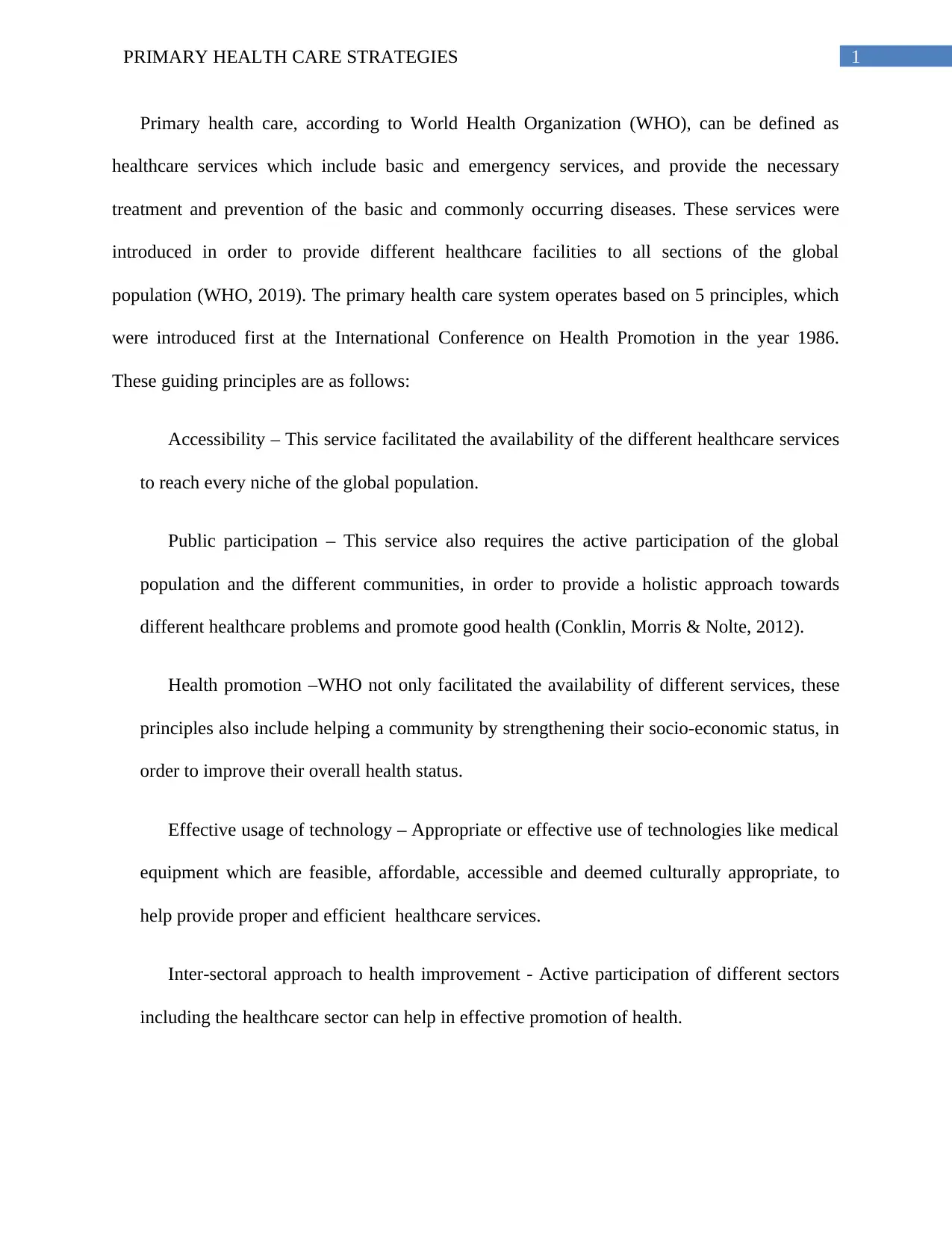
1PRIMARY HEALTH CARE STRATEGIES
Primary health care, according to World Health Organization (WHO), can be defined as
healthcare services which include basic and emergency services, and provide the necessary
treatment and prevention of the basic and commonly occurring diseases. These services were
introduced in order to provide different healthcare facilities to all sections of the global
population (WHO, 2019). The primary health care system operates based on 5 principles, which
were introduced first at the International Conference on Health Promotion in the year 1986.
These guiding principles are as follows:
Accessibility – This service facilitated the availability of the different healthcare services
to reach every niche of the global population.
Public participation – This service also requires the active participation of the global
population and the different communities, in order to provide a holistic approach towards
different healthcare problems and promote good health (Conklin, Morris & Nolte, 2012).
Health promotion –WHO not only facilitated the availability of different services, these
principles also include helping a community by strengthening their socio-economic status, in
order to improve their overall health status.
Effective usage of technology – Appropriate or effective use of technologies like medical
equipment which are feasible, affordable, accessible and deemed culturally appropriate, to
help provide proper and efficient healthcare services.
Inter-sectoral approach to health improvement - Active participation of different sectors
including the healthcare sector can help in effective promotion of health.
Primary health care, according to World Health Organization (WHO), can be defined as
healthcare services which include basic and emergency services, and provide the necessary
treatment and prevention of the basic and commonly occurring diseases. These services were
introduced in order to provide different healthcare facilities to all sections of the global
population (WHO, 2019). The primary health care system operates based on 5 principles, which
were introduced first at the International Conference on Health Promotion in the year 1986.
These guiding principles are as follows:
Accessibility – This service facilitated the availability of the different healthcare services
to reach every niche of the global population.
Public participation – This service also requires the active participation of the global
population and the different communities, in order to provide a holistic approach towards
different healthcare problems and promote good health (Conklin, Morris & Nolte, 2012).
Health promotion –WHO not only facilitated the availability of different services, these
principles also include helping a community by strengthening their socio-economic status, in
order to improve their overall health status.
Effective usage of technology – Appropriate or effective use of technologies like medical
equipment which are feasible, affordable, accessible and deemed culturally appropriate, to
help provide proper and efficient healthcare services.
Inter-sectoral approach to health improvement - Active participation of different sectors
including the healthcare sector can help in effective promotion of health.
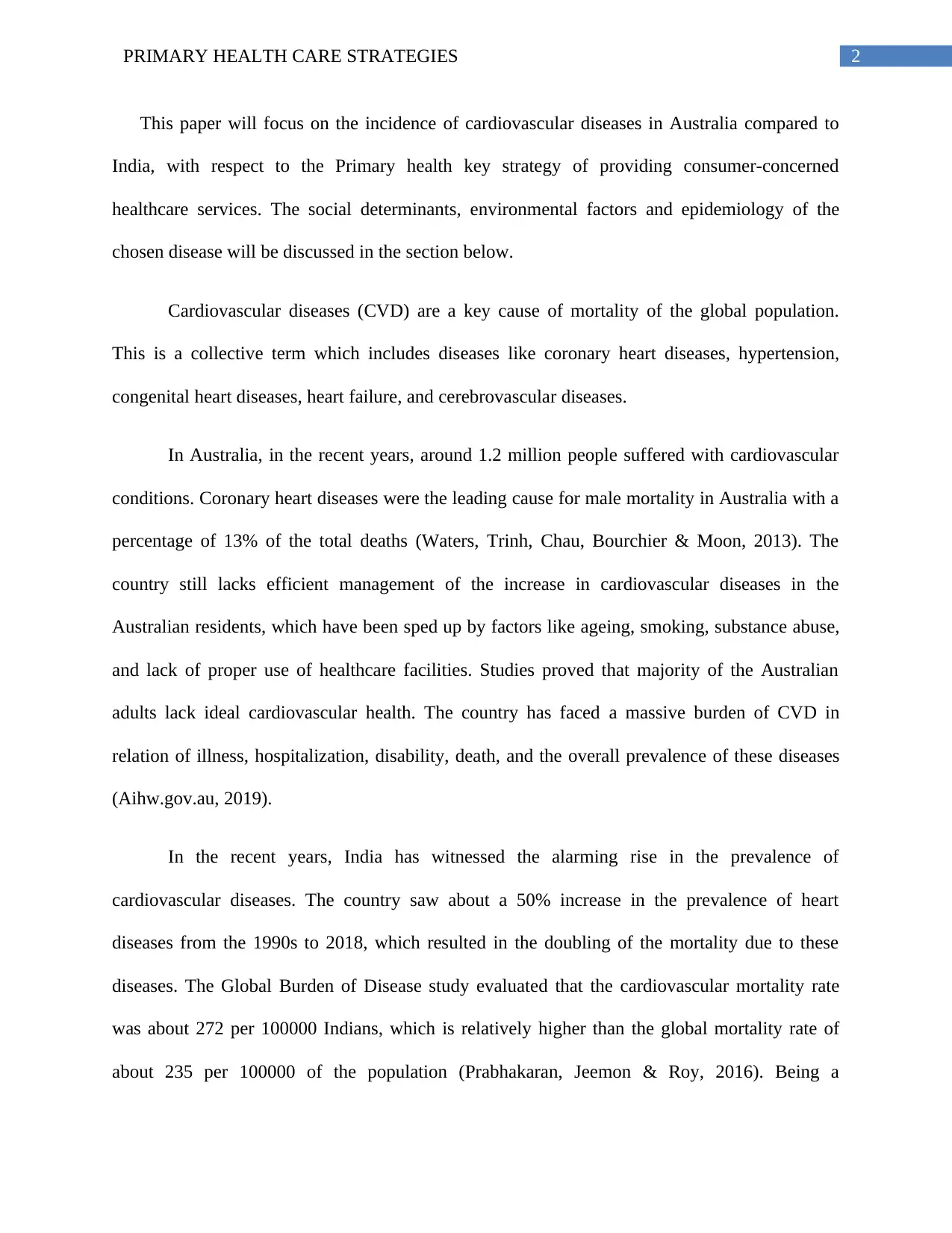
2PRIMARY HEALTH CARE STRATEGIES
This paper will focus on the incidence of cardiovascular diseases in Australia compared to
India, with respect to the Primary health key strategy of providing consumer-concerned
healthcare services. The social determinants, environmental factors and epidemiology of the
chosen disease will be discussed in the section below.
Cardiovascular diseases (CVD) are a key cause of mortality of the global population.
This is a collective term which includes diseases like coronary heart diseases, hypertension,
congenital heart diseases, heart failure, and cerebrovascular diseases.
In Australia, in the recent years, around 1.2 million people suffered with cardiovascular
conditions. Coronary heart diseases were the leading cause for male mortality in Australia with a
percentage of 13% of the total deaths (Waters, Trinh, Chau, Bourchier & Moon, 2013). The
country still lacks efficient management of the increase in cardiovascular diseases in the
Australian residents, which have been sped up by factors like ageing, smoking, substance abuse,
and lack of proper use of healthcare facilities. Studies proved that majority of the Australian
adults lack ideal cardiovascular health. The country has faced a massive burden of CVD in
relation of illness, hospitalization, disability, death, and the overall prevalence of these diseases
(Aihw.gov.au, 2019).
In the recent years, India has witnessed the alarming rise in the prevalence of
cardiovascular diseases. The country saw about a 50% increase in the prevalence of heart
diseases from the 1990s to 2018, which resulted in the doubling of the mortality due to these
diseases. The Global Burden of Disease study evaluated that the cardiovascular mortality rate
was about 272 per 100000 Indians, which is relatively higher than the global mortality rate of
about 235 per 100000 of the population (Prabhakaran, Jeemon & Roy, 2016). Being a
This paper will focus on the incidence of cardiovascular diseases in Australia compared to
India, with respect to the Primary health key strategy of providing consumer-concerned
healthcare services. The social determinants, environmental factors and epidemiology of the
chosen disease will be discussed in the section below.
Cardiovascular diseases (CVD) are a key cause of mortality of the global population.
This is a collective term which includes diseases like coronary heart diseases, hypertension,
congenital heart diseases, heart failure, and cerebrovascular diseases.
In Australia, in the recent years, around 1.2 million people suffered with cardiovascular
conditions. Coronary heart diseases were the leading cause for male mortality in Australia with a
percentage of 13% of the total deaths (Waters, Trinh, Chau, Bourchier & Moon, 2013). The
country still lacks efficient management of the increase in cardiovascular diseases in the
Australian residents, which have been sped up by factors like ageing, smoking, substance abuse,
and lack of proper use of healthcare facilities. Studies proved that majority of the Australian
adults lack ideal cardiovascular health. The country has faced a massive burden of CVD in
relation of illness, hospitalization, disability, death, and the overall prevalence of these diseases
(Aihw.gov.au, 2019).
In the recent years, India has witnessed the alarming rise in the prevalence of
cardiovascular diseases. The country saw about a 50% increase in the prevalence of heart
diseases from the 1990s to 2018, which resulted in the doubling of the mortality due to these
diseases. The Global Burden of Disease study evaluated that the cardiovascular mortality rate
was about 272 per 100000 Indians, which is relatively higher than the global mortality rate of
about 235 per 100000 of the population (Prabhakaran, Jeemon & Roy, 2016). Being a
⊘ This is a preview!⊘
Do you want full access?
Subscribe today to unlock all pages.

Trusted by 1+ million students worldwide
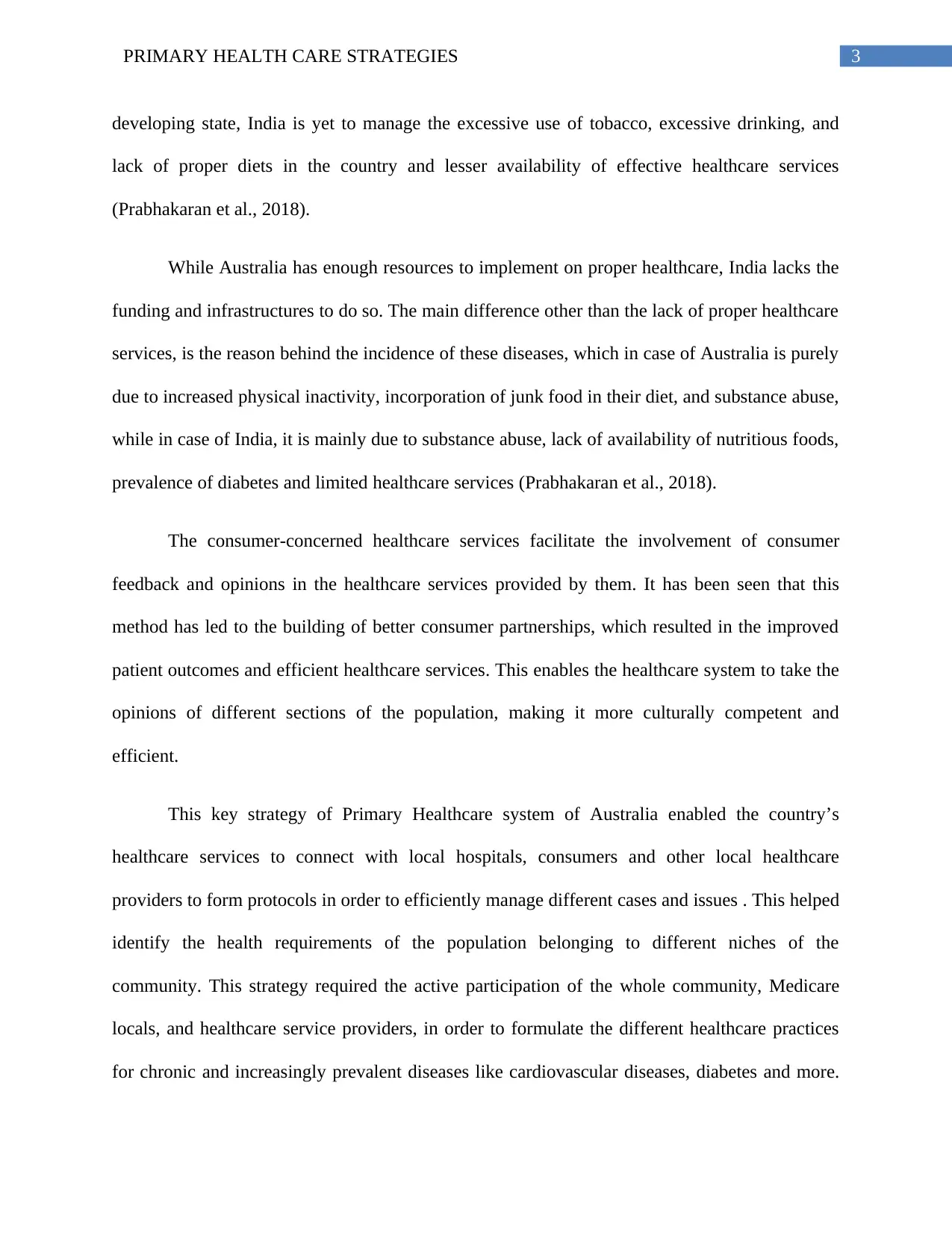
3PRIMARY HEALTH CARE STRATEGIES
developing state, India is yet to manage the excessive use of tobacco, excessive drinking, and
lack of proper diets in the country and lesser availability of effective healthcare services
(Prabhakaran et al., 2018).
While Australia has enough resources to implement on proper healthcare, India lacks the
funding and infrastructures to do so. The main difference other than the lack of proper healthcare
services, is the reason behind the incidence of these diseases, which in case of Australia is purely
due to increased physical inactivity, incorporation of junk food in their diet, and substance abuse,
while in case of India, it is mainly due to substance abuse, lack of availability of nutritious foods,
prevalence of diabetes and limited healthcare services (Prabhakaran et al., 2018).
The consumer-concerned healthcare services facilitate the involvement of consumer
feedback and opinions in the healthcare services provided by them. It has been seen that this
method has led to the building of better consumer partnerships, which resulted in the improved
patient outcomes and efficient healthcare services. This enables the healthcare system to take the
opinions of different sections of the population, making it more culturally competent and
efficient.
This key strategy of Primary Healthcare system of Australia enabled the country’s
healthcare services to connect with local hospitals, consumers and other local healthcare
providers to form protocols in order to efficiently manage different cases and issues . This helped
identify the health requirements of the population belonging to different niches of the
community. This strategy required the active participation of the whole community, Medicare
locals, and healthcare service providers, in order to formulate the different healthcare practices
for chronic and increasingly prevalent diseases like cardiovascular diseases, diabetes and more.
developing state, India is yet to manage the excessive use of tobacco, excessive drinking, and
lack of proper diets in the country and lesser availability of effective healthcare services
(Prabhakaran et al., 2018).
While Australia has enough resources to implement on proper healthcare, India lacks the
funding and infrastructures to do so. The main difference other than the lack of proper healthcare
services, is the reason behind the incidence of these diseases, which in case of Australia is purely
due to increased physical inactivity, incorporation of junk food in their diet, and substance abuse,
while in case of India, it is mainly due to substance abuse, lack of availability of nutritious foods,
prevalence of diabetes and limited healthcare services (Prabhakaran et al., 2018).
The consumer-concerned healthcare services facilitate the involvement of consumer
feedback and opinions in the healthcare services provided by them. It has been seen that this
method has led to the building of better consumer partnerships, which resulted in the improved
patient outcomes and efficient healthcare services. This enables the healthcare system to take the
opinions of different sections of the population, making it more culturally competent and
efficient.
This key strategy of Primary Healthcare system of Australia enabled the country’s
healthcare services to connect with local hospitals, consumers and other local healthcare
providers to form protocols in order to efficiently manage different cases and issues . This helped
identify the health requirements of the population belonging to different niches of the
community. This strategy required the active participation of the whole community, Medicare
locals, and healthcare service providers, in order to formulate the different healthcare practices
for chronic and increasingly prevalent diseases like cardiovascular diseases, diabetes and more.
Paraphrase This Document
Need a fresh take? Get an instant paraphrase of this document with our AI Paraphraser
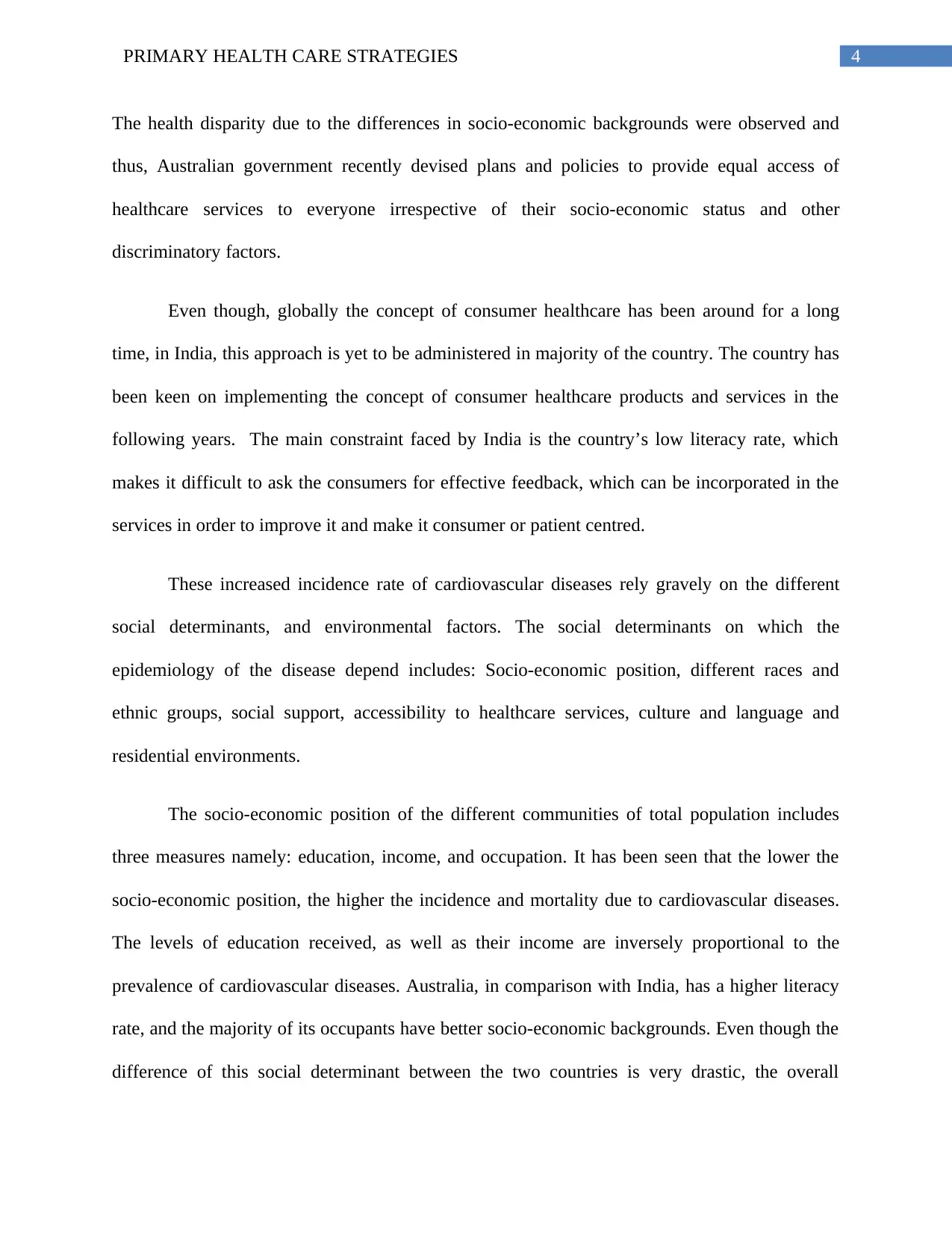
4PRIMARY HEALTH CARE STRATEGIES
The health disparity due to the differences in socio-economic backgrounds were observed and
thus, Australian government recently devised plans and policies to provide equal access of
healthcare services to everyone irrespective of their socio-economic status and other
discriminatory factors.
Even though, globally the concept of consumer healthcare has been around for a long
time, in India, this approach is yet to be administered in majority of the country. The country has
been keen on implementing the concept of consumer healthcare products and services in the
following years. The main constraint faced by India is the country’s low literacy rate, which
makes it difficult to ask the consumers for effective feedback, which can be incorporated in the
services in order to improve it and make it consumer or patient centred.
These increased incidence rate of cardiovascular diseases rely gravely on the different
social determinants, and environmental factors. The social determinants on which the
epidemiology of the disease depend includes: Socio-economic position, different races and
ethnic groups, social support, accessibility to healthcare services, culture and language and
residential environments.
The socio-economic position of the different communities of total population includes
three measures namely: education, income, and occupation. It has been seen that the lower the
socio-economic position, the higher the incidence and mortality due to cardiovascular diseases.
The levels of education received, as well as their income are inversely proportional to the
prevalence of cardiovascular diseases. Australia, in comparison with India, has a higher literacy
rate, and the majority of its occupants have better socio-economic backgrounds. Even though the
difference of this social determinant between the two countries is very drastic, the overall
The health disparity due to the differences in socio-economic backgrounds were observed and
thus, Australian government recently devised plans and policies to provide equal access of
healthcare services to everyone irrespective of their socio-economic status and other
discriminatory factors.
Even though, globally the concept of consumer healthcare has been around for a long
time, in India, this approach is yet to be administered in majority of the country. The country has
been keen on implementing the concept of consumer healthcare products and services in the
following years. The main constraint faced by India is the country’s low literacy rate, which
makes it difficult to ask the consumers for effective feedback, which can be incorporated in the
services in order to improve it and make it consumer or patient centred.
These increased incidence rate of cardiovascular diseases rely gravely on the different
social determinants, and environmental factors. The social determinants on which the
epidemiology of the disease depend includes: Socio-economic position, different races and
ethnic groups, social support, accessibility to healthcare services, culture and language and
residential environments.
The socio-economic position of the different communities of total population includes
three measures namely: education, income, and occupation. It has been seen that the lower the
socio-economic position, the higher the incidence and mortality due to cardiovascular diseases.
The levels of education received, as well as their income are inversely proportional to the
prevalence of cardiovascular diseases. Australia, in comparison with India, has a higher literacy
rate, and the majority of its occupants have better socio-economic backgrounds. Even though the
difference of this social determinant between the two countries is very drastic, the overall
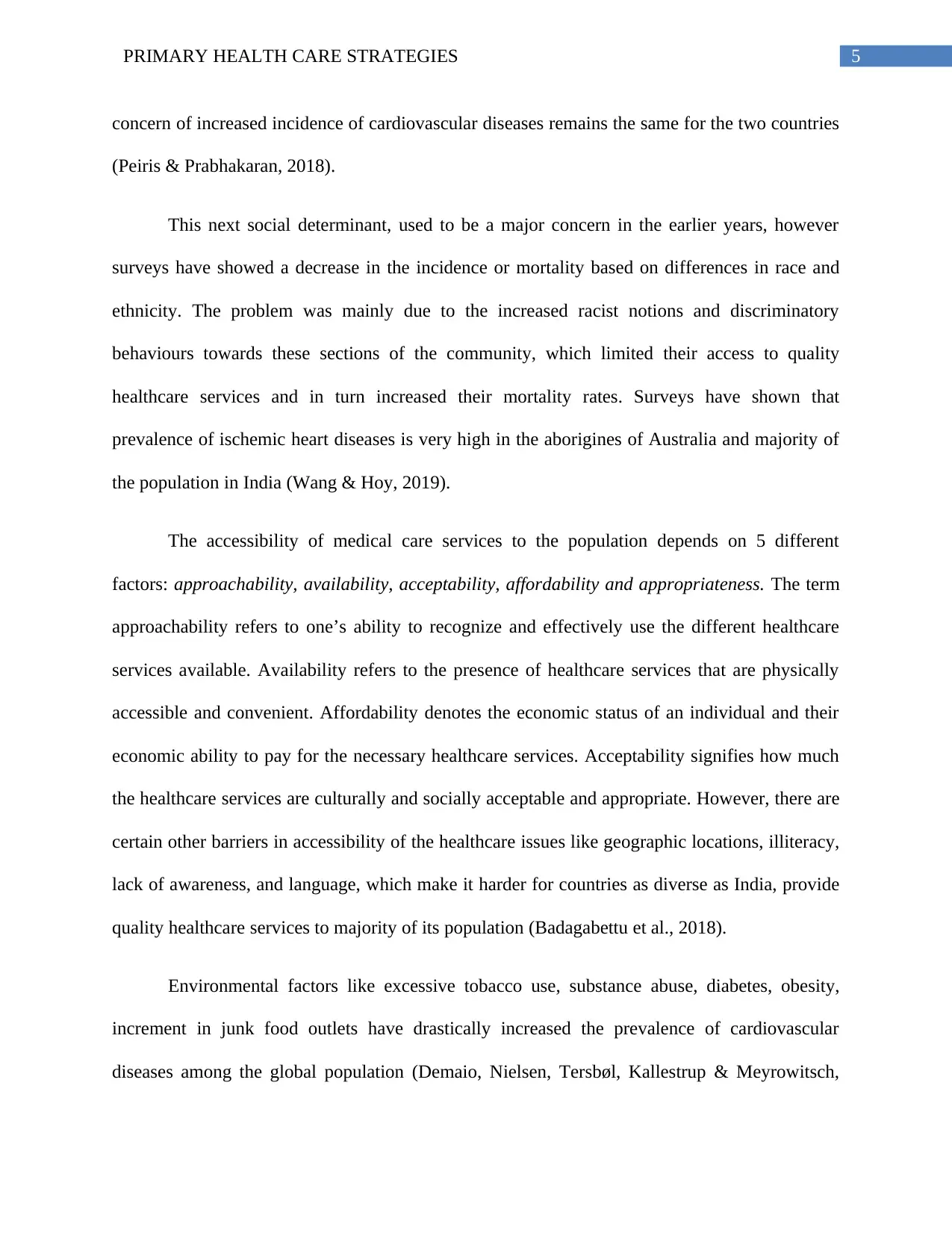
5PRIMARY HEALTH CARE STRATEGIES
concern of increased incidence of cardiovascular diseases remains the same for the two countries
(Peiris & Prabhakaran, 2018).
This next social determinant, used to be a major concern in the earlier years, however
surveys have showed a decrease in the incidence or mortality based on differences in race and
ethnicity. The problem was mainly due to the increased racist notions and discriminatory
behaviours towards these sections of the community, which limited their access to quality
healthcare services and in turn increased their mortality rates. Surveys have shown that
prevalence of ischemic heart diseases is very high in the aborigines of Australia and majority of
the population in India (Wang & Hoy, 2019).
The accessibility of medical care services to the population depends on 5 different
factors: approachability, availability, acceptability, affordability and appropriateness. The term
approachability refers to one’s ability to recognize and effectively use the different healthcare
services available. Availability refers to the presence of healthcare services that are physically
accessible and convenient. Affordability denotes the economic status of an individual and their
economic ability to pay for the necessary healthcare services. Acceptability signifies how much
the healthcare services are culturally and socially acceptable and appropriate. However, there are
certain other barriers in accessibility of the healthcare issues like geographic locations, illiteracy,
lack of awareness, and language, which make it harder for countries as diverse as India, provide
quality healthcare services to majority of its population (Badagabettu et al., 2018).
Environmental factors like excessive tobacco use, substance abuse, diabetes, obesity,
increment in junk food outlets have drastically increased the prevalence of cardiovascular
diseases among the global population (Demaio, Nielsen, Tersbøl, Kallestrup & Meyrowitsch,
concern of increased incidence of cardiovascular diseases remains the same for the two countries
(Peiris & Prabhakaran, 2018).
This next social determinant, used to be a major concern in the earlier years, however
surveys have showed a decrease in the incidence or mortality based on differences in race and
ethnicity. The problem was mainly due to the increased racist notions and discriminatory
behaviours towards these sections of the community, which limited their access to quality
healthcare services and in turn increased their mortality rates. Surveys have shown that
prevalence of ischemic heart diseases is very high in the aborigines of Australia and majority of
the population in India (Wang & Hoy, 2019).
The accessibility of medical care services to the population depends on 5 different
factors: approachability, availability, acceptability, affordability and appropriateness. The term
approachability refers to one’s ability to recognize and effectively use the different healthcare
services available. Availability refers to the presence of healthcare services that are physically
accessible and convenient. Affordability denotes the economic status of an individual and their
economic ability to pay for the necessary healthcare services. Acceptability signifies how much
the healthcare services are culturally and socially acceptable and appropriate. However, there are
certain other barriers in accessibility of the healthcare issues like geographic locations, illiteracy,
lack of awareness, and language, which make it harder for countries as diverse as India, provide
quality healthcare services to majority of its population (Badagabettu et al., 2018).
Environmental factors like excessive tobacco use, substance abuse, diabetes, obesity,
increment in junk food outlets have drastically increased the prevalence of cardiovascular
diseases among the global population (Demaio, Nielsen, Tersbøl, Kallestrup & Meyrowitsch,
⊘ This is a preview!⊘
Do you want full access?
Subscribe today to unlock all pages.

Trusted by 1+ million students worldwide
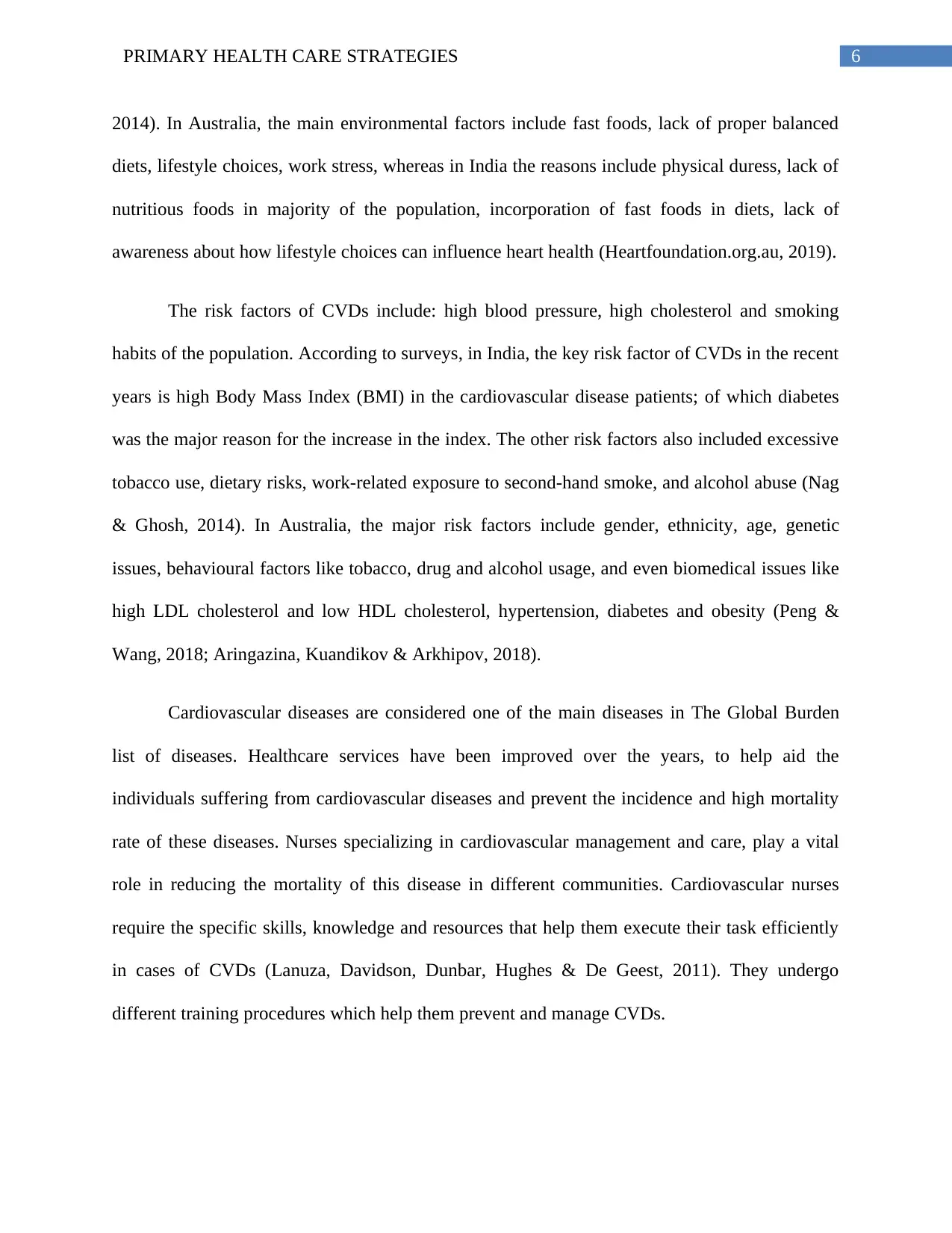
6PRIMARY HEALTH CARE STRATEGIES
2014). In Australia, the main environmental factors include fast foods, lack of proper balanced
diets, lifestyle choices, work stress, whereas in India the reasons include physical duress, lack of
nutritious foods in majority of the population, incorporation of fast foods in diets, lack of
awareness about how lifestyle choices can influence heart health (Heartfoundation.org.au, 2019).
The risk factors of CVDs include: high blood pressure, high cholesterol and smoking
habits of the population. According to surveys, in India, the key risk factor of CVDs in the recent
years is high Body Mass Index (BMI) in the cardiovascular disease patients; of which diabetes
was the major reason for the increase in the index. The other risk factors also included excessive
tobacco use, dietary risks, work-related exposure to second-hand smoke, and alcohol abuse (Nag
& Ghosh, 2014). In Australia, the major risk factors include gender, ethnicity, age, genetic
issues, behavioural factors like tobacco, drug and alcohol usage, and even biomedical issues like
high LDL cholesterol and low HDL cholesterol, hypertension, diabetes and obesity (Peng &
Wang, 2018; Aringazina, Kuandikov & Arkhipov, 2018).
Cardiovascular diseases are considered one of the main diseases in The Global Burden
list of diseases. Healthcare services have been improved over the years, to help aid the
individuals suffering from cardiovascular diseases and prevent the incidence and high mortality
rate of these diseases. Nurses specializing in cardiovascular management and care, play a vital
role in reducing the mortality of this disease in different communities. Cardiovascular nurses
require the specific skills, knowledge and resources that help them execute their task efficiently
in cases of CVDs (Lanuza, Davidson, Dunbar, Hughes & De Geest, 2011). They undergo
different training procedures which help them prevent and manage CVDs.
2014). In Australia, the main environmental factors include fast foods, lack of proper balanced
diets, lifestyle choices, work stress, whereas in India the reasons include physical duress, lack of
nutritious foods in majority of the population, incorporation of fast foods in diets, lack of
awareness about how lifestyle choices can influence heart health (Heartfoundation.org.au, 2019).
The risk factors of CVDs include: high blood pressure, high cholesterol and smoking
habits of the population. According to surveys, in India, the key risk factor of CVDs in the recent
years is high Body Mass Index (BMI) in the cardiovascular disease patients; of which diabetes
was the major reason for the increase in the index. The other risk factors also included excessive
tobacco use, dietary risks, work-related exposure to second-hand smoke, and alcohol abuse (Nag
& Ghosh, 2014). In Australia, the major risk factors include gender, ethnicity, age, genetic
issues, behavioural factors like tobacco, drug and alcohol usage, and even biomedical issues like
high LDL cholesterol and low HDL cholesterol, hypertension, diabetes and obesity (Peng &
Wang, 2018; Aringazina, Kuandikov & Arkhipov, 2018).
Cardiovascular diseases are considered one of the main diseases in The Global Burden
list of diseases. Healthcare services have been improved over the years, to help aid the
individuals suffering from cardiovascular diseases and prevent the incidence and high mortality
rate of these diseases. Nurses specializing in cardiovascular management and care, play a vital
role in reducing the mortality of this disease in different communities. Cardiovascular nurses
require the specific skills, knowledge and resources that help them execute their task efficiently
in cases of CVDs (Lanuza, Davidson, Dunbar, Hughes & De Geest, 2011). They undergo
different training procedures which help them prevent and manage CVDs.
Paraphrase This Document
Need a fresh take? Get an instant paraphrase of this document with our AI Paraphraser
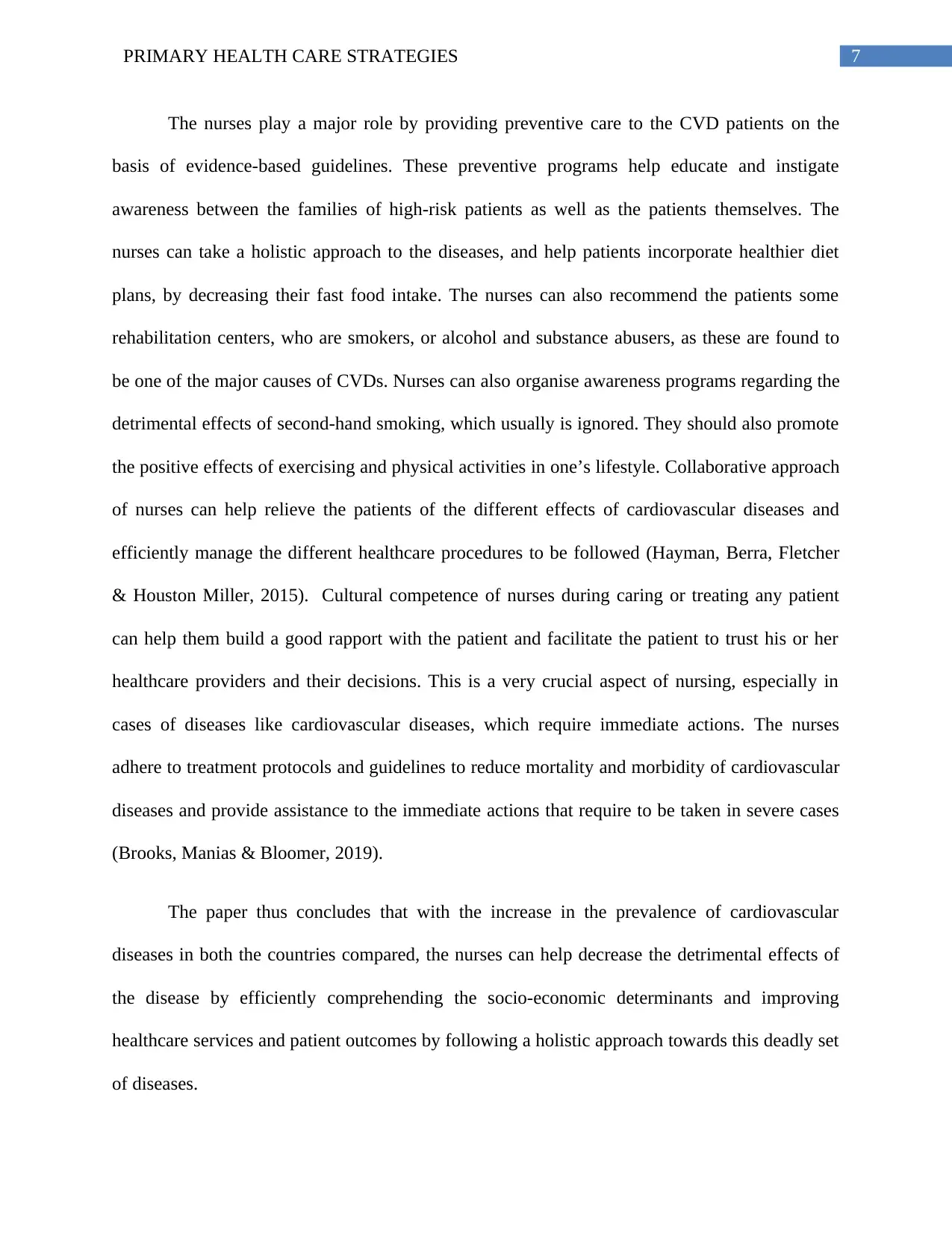
7PRIMARY HEALTH CARE STRATEGIES
The nurses play a major role by providing preventive care to the CVD patients on the
basis of evidence-based guidelines. These preventive programs help educate and instigate
awareness between the families of high-risk patients as well as the patients themselves. The
nurses can take a holistic approach to the diseases, and help patients incorporate healthier diet
plans, by decreasing their fast food intake. The nurses can also recommend the patients some
rehabilitation centers, who are smokers, or alcohol and substance abusers, as these are found to
be one of the major causes of CVDs. Nurses can also organise awareness programs regarding the
detrimental effects of second-hand smoking, which usually is ignored. They should also promote
the positive effects of exercising and physical activities in one’s lifestyle. Collaborative approach
of nurses can help relieve the patients of the different effects of cardiovascular diseases and
efficiently manage the different healthcare procedures to be followed (Hayman, Berra, Fletcher
& Houston Miller, 2015). Cultural competence of nurses during caring or treating any patient
can help them build a good rapport with the patient and facilitate the patient to trust his or her
healthcare providers and their decisions. This is a very crucial aspect of nursing, especially in
cases of diseases like cardiovascular diseases, which require immediate actions. The nurses
adhere to treatment protocols and guidelines to reduce mortality and morbidity of cardiovascular
diseases and provide assistance to the immediate actions that require to be taken in severe cases
(Brooks, Manias & Bloomer, 2019).
The paper thus concludes that with the increase in the prevalence of cardiovascular
diseases in both the countries compared, the nurses can help decrease the detrimental effects of
the disease by efficiently comprehending the socio-economic determinants and improving
healthcare services and patient outcomes by following a holistic approach towards this deadly set
of diseases.
The nurses play a major role by providing preventive care to the CVD patients on the
basis of evidence-based guidelines. These preventive programs help educate and instigate
awareness between the families of high-risk patients as well as the patients themselves. The
nurses can take a holistic approach to the diseases, and help patients incorporate healthier diet
plans, by decreasing their fast food intake. The nurses can also recommend the patients some
rehabilitation centers, who are smokers, or alcohol and substance abusers, as these are found to
be one of the major causes of CVDs. Nurses can also organise awareness programs regarding the
detrimental effects of second-hand smoking, which usually is ignored. They should also promote
the positive effects of exercising and physical activities in one’s lifestyle. Collaborative approach
of nurses can help relieve the patients of the different effects of cardiovascular diseases and
efficiently manage the different healthcare procedures to be followed (Hayman, Berra, Fletcher
& Houston Miller, 2015). Cultural competence of nurses during caring or treating any patient
can help them build a good rapport with the patient and facilitate the patient to trust his or her
healthcare providers and their decisions. This is a very crucial aspect of nursing, especially in
cases of diseases like cardiovascular diseases, which require immediate actions. The nurses
adhere to treatment protocols and guidelines to reduce mortality and morbidity of cardiovascular
diseases and provide assistance to the immediate actions that require to be taken in severe cases
(Brooks, Manias & Bloomer, 2019).
The paper thus concludes that with the increase in the prevalence of cardiovascular
diseases in both the countries compared, the nurses can help decrease the detrimental effects of
the disease by efficiently comprehending the socio-economic determinants and improving
healthcare services and patient outcomes by following a holistic approach towards this deadly set
of diseases.
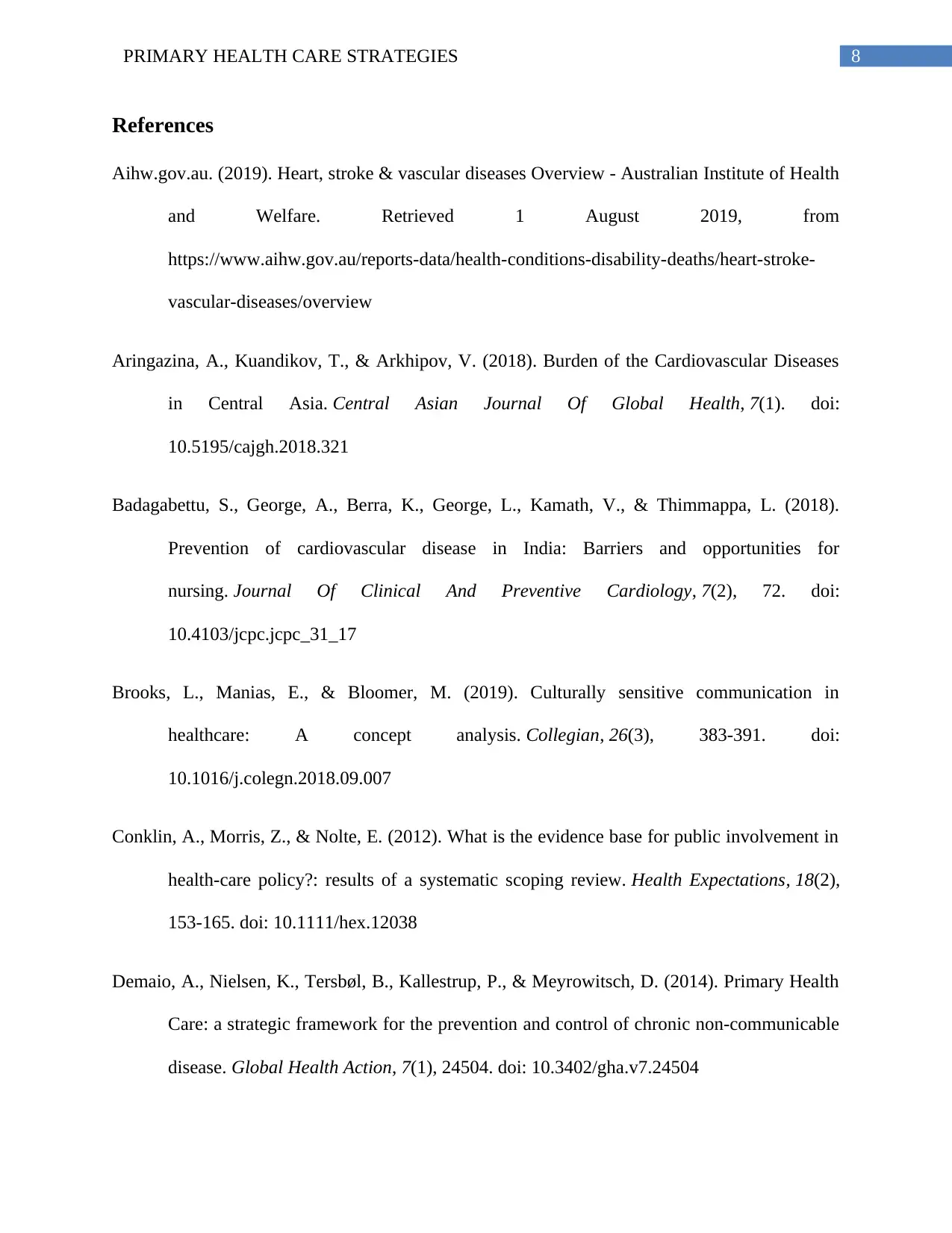
8PRIMARY HEALTH CARE STRATEGIES
References
Aihw.gov.au. (2019). Heart, stroke & vascular diseases Overview - Australian Institute of Health
and Welfare. Retrieved 1 August 2019, from
https://www.aihw.gov.au/reports-data/health-conditions-disability-deaths/heart-stroke-
vascular-diseases/overview
Aringazina, A., Kuandikov, T., & Arkhipov, V. (2018). Burden of the Cardiovascular Diseases
in Central Asia. Central Asian Journal Of Global Health, 7(1). doi:
10.5195/cajgh.2018.321
Badagabettu, S., George, A., Berra, K., George, L., Kamath, V., & Thimmappa, L. (2018).
Prevention of cardiovascular disease in India: Barriers and opportunities for
nursing. Journal Of Clinical And Preventive Cardiology, 7(2), 72. doi:
10.4103/jcpc.jcpc_31_17
Brooks, L., Manias, E., & Bloomer, M. (2019). Culturally sensitive communication in
healthcare: A concept analysis. Collegian, 26(3), 383-391. doi:
10.1016/j.colegn.2018.09.007
Conklin, A., Morris, Z., & Nolte, E. (2012). What is the evidence base for public involvement in
health-care policy?: results of a systematic scoping review. Health Expectations, 18(2),
153-165. doi: 10.1111/hex.12038
Demaio, A., Nielsen, K., Tersbøl, B., Kallestrup, P., & Meyrowitsch, D. (2014). Primary Health
Care: a strategic framework for the prevention and control of chronic non-communicable
disease. Global Health Action, 7(1), 24504. doi: 10.3402/gha.v7.24504
References
Aihw.gov.au. (2019). Heart, stroke & vascular diseases Overview - Australian Institute of Health
and Welfare. Retrieved 1 August 2019, from
https://www.aihw.gov.au/reports-data/health-conditions-disability-deaths/heart-stroke-
vascular-diseases/overview
Aringazina, A., Kuandikov, T., & Arkhipov, V. (2018). Burden of the Cardiovascular Diseases
in Central Asia. Central Asian Journal Of Global Health, 7(1). doi:
10.5195/cajgh.2018.321
Badagabettu, S., George, A., Berra, K., George, L., Kamath, V., & Thimmappa, L. (2018).
Prevention of cardiovascular disease in India: Barriers and opportunities for
nursing. Journal Of Clinical And Preventive Cardiology, 7(2), 72. doi:
10.4103/jcpc.jcpc_31_17
Brooks, L., Manias, E., & Bloomer, M. (2019). Culturally sensitive communication in
healthcare: A concept analysis. Collegian, 26(3), 383-391. doi:
10.1016/j.colegn.2018.09.007
Conklin, A., Morris, Z., & Nolte, E. (2012). What is the evidence base for public involvement in
health-care policy?: results of a systematic scoping review. Health Expectations, 18(2),
153-165. doi: 10.1111/hex.12038
Demaio, A., Nielsen, K., Tersbøl, B., Kallestrup, P., & Meyrowitsch, D. (2014). Primary Health
Care: a strategic framework for the prevention and control of chronic non-communicable
disease. Global Health Action, 7(1), 24504. doi: 10.3402/gha.v7.24504
⊘ This is a preview!⊘
Do you want full access?
Subscribe today to unlock all pages.

Trusted by 1+ million students worldwide
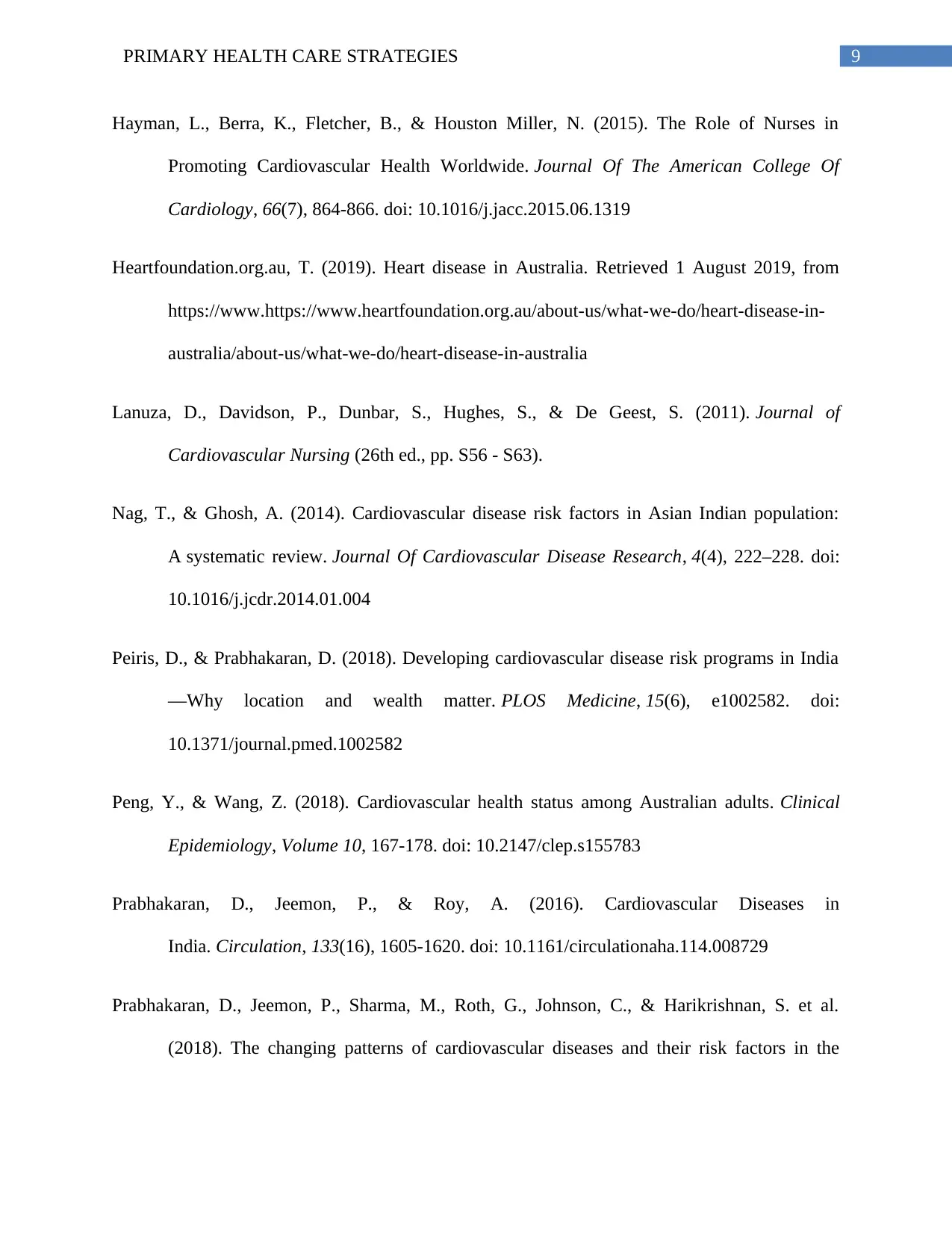
9PRIMARY HEALTH CARE STRATEGIES
Hayman, L., Berra, K., Fletcher, B., & Houston Miller, N. (2015). The Role of Nurses in
Promoting Cardiovascular Health Worldwide. Journal Of The American College Of
Cardiology, 66(7), 864-866. doi: 10.1016/j.jacc.2015.06.1319
Heartfoundation.org.au, T. (2019). Heart disease in Australia. Retrieved 1 August 2019, from
https://www.https://www.heartfoundation.org.au/about-us/what-we-do/heart-disease-in-
australia/about-us/what-we-do/heart-disease-in-australia
Lanuza, D., Davidson, P., Dunbar, S., Hughes, S., & De Geest, S. (2011). Journal of
Cardiovascular Nursing (26th ed., pp. S56 - S63).
Nag, T., & Ghosh, A. (2014). Cardiovascular disease risk factors in Asian Indian population:
A systematic review. Journal Of Cardiovascular Disease Research, 4(4), 222–228. doi:
10.1016/j.jcdr.2014.01.004
Peiris, D., & Prabhakaran, D. (2018). Developing cardiovascular disease risk programs in India
—Why location and wealth matter. PLOS Medicine, 15(6), e1002582. doi:
10.1371/journal.pmed.1002582
Peng, Y., & Wang, Z. (2018). Cardiovascular health status among Australian adults. Clinical
Epidemiology, Volume 10, 167-178. doi: 10.2147/clep.s155783
Prabhakaran, D., Jeemon, P., & Roy, A. (2016). Cardiovascular Diseases in
India. Circulation, 133(16), 1605-1620. doi: 10.1161/circulationaha.114.008729
Prabhakaran, D., Jeemon, P., Sharma, M., Roth, G., Johnson, C., & Harikrishnan, S. et al.
(2018). The changing patterns of cardiovascular diseases and their risk factors in the
Hayman, L., Berra, K., Fletcher, B., & Houston Miller, N. (2015). The Role of Nurses in
Promoting Cardiovascular Health Worldwide. Journal Of The American College Of
Cardiology, 66(7), 864-866. doi: 10.1016/j.jacc.2015.06.1319
Heartfoundation.org.au, T. (2019). Heart disease in Australia. Retrieved 1 August 2019, from
https://www.https://www.heartfoundation.org.au/about-us/what-we-do/heart-disease-in-
australia/about-us/what-we-do/heart-disease-in-australia
Lanuza, D., Davidson, P., Dunbar, S., Hughes, S., & De Geest, S. (2011). Journal of
Cardiovascular Nursing (26th ed., pp. S56 - S63).
Nag, T., & Ghosh, A. (2014). Cardiovascular disease risk factors in Asian Indian population:
A systematic review. Journal Of Cardiovascular Disease Research, 4(4), 222–228. doi:
10.1016/j.jcdr.2014.01.004
Peiris, D., & Prabhakaran, D. (2018). Developing cardiovascular disease risk programs in India
—Why location and wealth matter. PLOS Medicine, 15(6), e1002582. doi:
10.1371/journal.pmed.1002582
Peng, Y., & Wang, Z. (2018). Cardiovascular health status among Australian adults. Clinical
Epidemiology, Volume 10, 167-178. doi: 10.2147/clep.s155783
Prabhakaran, D., Jeemon, P., & Roy, A. (2016). Cardiovascular Diseases in
India. Circulation, 133(16), 1605-1620. doi: 10.1161/circulationaha.114.008729
Prabhakaran, D., Jeemon, P., Sharma, M., Roth, G., Johnson, C., & Harikrishnan, S. et al.
(2018). The changing patterns of cardiovascular diseases and their risk factors in the
Paraphrase This Document
Need a fresh take? Get an instant paraphrase of this document with our AI Paraphraser
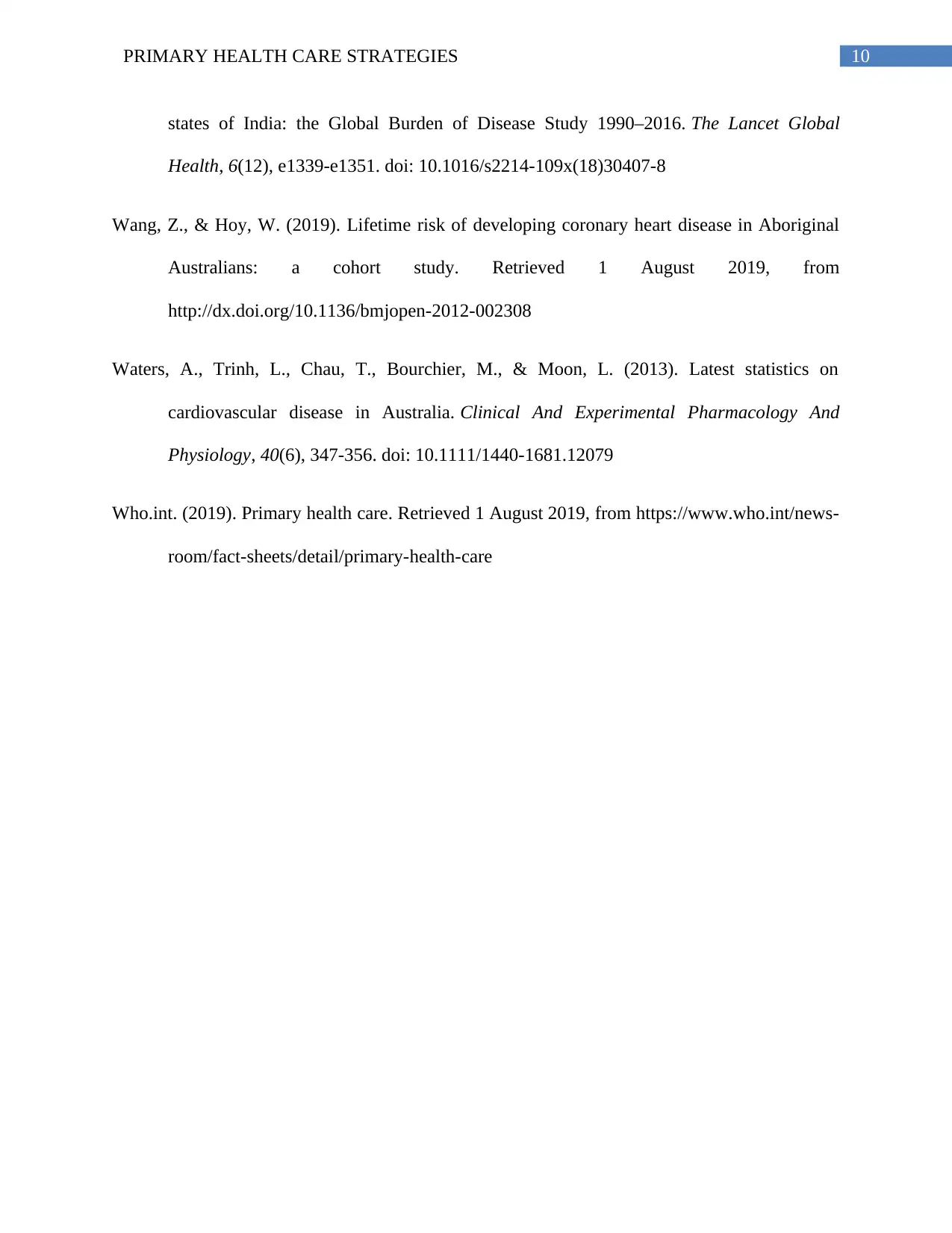
10PRIMARY HEALTH CARE STRATEGIES
states of India: the Global Burden of Disease Study 1990–2016. The Lancet Global
Health, 6(12), e1339-e1351. doi: 10.1016/s2214-109x(18)30407-8
Wang, Z., & Hoy, W. (2019). Lifetime risk of developing coronary heart disease in Aboriginal
Australians: a cohort study. Retrieved 1 August 2019, from
http://dx.doi.org/10.1136/bmjopen-2012-002308
Waters, A., Trinh, L., Chau, T., Bourchier, M., & Moon, L. (2013). Latest statistics on
cardiovascular disease in Australia. Clinical And Experimental Pharmacology And
Physiology, 40(6), 347-356. doi: 10.1111/1440-1681.12079
Who.int. (2019). Primary health care. Retrieved 1 August 2019, from https://www.who.int/news-
room/fact-sheets/detail/primary-health-care
states of India: the Global Burden of Disease Study 1990–2016. The Lancet Global
Health, 6(12), e1339-e1351. doi: 10.1016/s2214-109x(18)30407-8
Wang, Z., & Hoy, W. (2019). Lifetime risk of developing coronary heart disease in Aboriginal
Australians: a cohort study. Retrieved 1 August 2019, from
http://dx.doi.org/10.1136/bmjopen-2012-002308
Waters, A., Trinh, L., Chau, T., Bourchier, M., & Moon, L. (2013). Latest statistics on
cardiovascular disease in Australia. Clinical And Experimental Pharmacology And
Physiology, 40(6), 347-356. doi: 10.1111/1440-1681.12079
Who.int. (2019). Primary health care. Retrieved 1 August 2019, from https://www.who.int/news-
room/fact-sheets/detail/primary-health-care
1 out of 11
Related Documents
Your All-in-One AI-Powered Toolkit for Academic Success.
+13062052269
info@desklib.com
Available 24*7 on WhatsApp / Email
![[object Object]](/_next/static/media/star-bottom.7253800d.svg)
Unlock your academic potential
Copyright © 2020–2025 A2Z Services. All Rights Reserved. Developed and managed by ZUCOL.





